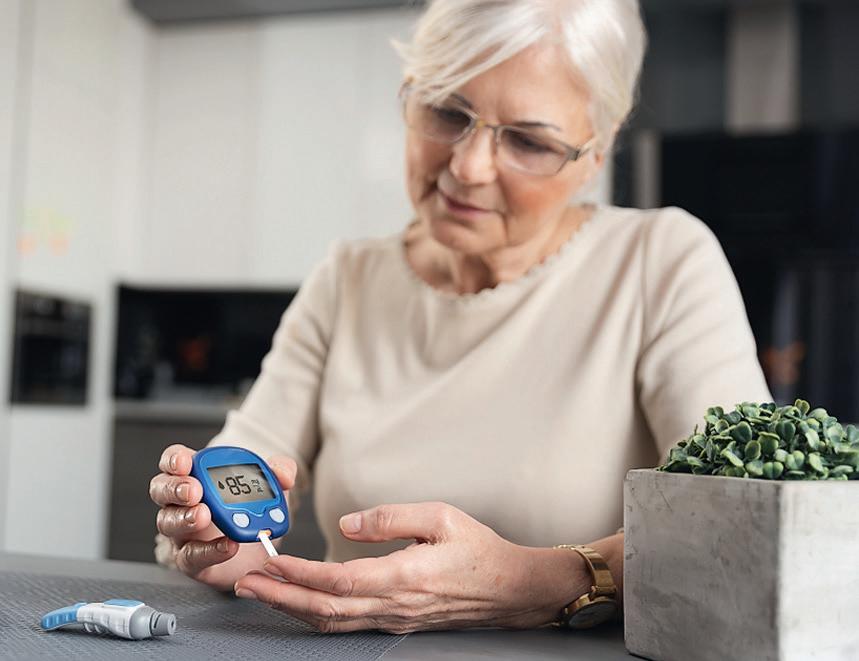CONQUERING
DIABETES: Angels Care provides tips on how to prevent and take control of the disease By Angels Care Home Health
D
Diabetes is a chronic condition that affects more than 12 million people who are 65 years and older, so chances are high that many seniors in our community have the disease or at least know someone with it. Diabetes is characterized by having too much glucose, or sugar, in the blood. Some sugar in the blood is okay, but too much sugar is dangerous. Our bodies get glucose – or sugar – primarily from the foods we eat. If our body works the way it should, glucose moves from our bloodstream into our cells where it is converted into energy. Insulin is a hormone that helps facilitate this process. Unfortunately, our body doesn’t always work the way we want it to. Diabetes sets in when we don’t make enough insulin or the insulin doesn’t work the way it should, and too much sugar stays in the blood. Diabetes can cause serious damage to the body if not managed properly, contributing to heart disease, stroke, high blood pressure, blindness, kidney disease, and amputation. In fact, nearly 30 million people who have diabetes as a primary condition need emergency care, reports the Centers for Disease Control and Prevention. It’s a disease that requires a tremendous amount of monitoring and self-care. Following is more information about the types of Diabetes, tips on how to prevent the disease, as well as management strategies if you or a loved one already have or have been diagnosed with Diabetes so that you can take control of it, avoid emergency care, and enjoy an active, independent lifestyle. TYPES OF DIABETES With type 1 diabetes, the body does not make insulin. A person who has type 1 diabetes must take insulin daily to live. Type 1 diabetes accounts for about 5 to 10 percent of diagnosed diabetes in the United States, according to
the National Institutes of Health. It develops most often in children and young adults but can appear at any age. Symptoms may include increased thirst and urination, constant hunger, weight loss, blurred vision, and extreme fatigue. If not diagnosed and treated with insulin, a person with type 1 diabetes can lapse into a life-threatening diabetic coma. We have no control over this type of diabetes. With type 2 diabetes, which is the more common type, the body does not make or use insulin well. Often by making healthier lifestyle choices, such as losing weight or exercising or eating healthier foods, we can keep the disease from worsening and damaging our bodies. Type 2 diabetes is most often associated with older age, obesity, family history of diabetes, previous history of gestational diabetes, physical inactivity, and certain ethnicities. About 80 percent of people with type 2 diabetes are overweight or obese, reports the National Institutes of Health. The symptoms of type 2 diabetes are similar to those of type 1 diabetes, but they develop gradually. Symptoms may include fatigue, frequent urination, increased thirst and hunger, weight loss, blurred vision, and slow healing of wounds or sores. Some people have no symptoms. PREVENTION AND MANAGEMENT STRATEGIES The good news is that there is a lot that can be done to prevent or delay diabetes. Studies show that people can lower their risk of developing diabetes by losing 5 to 7 percent of their body weight through diet and exercise. In fact, a major study of more than 3,000 people with prediabetes found that diet and exercise resulting in a 5 to 7 percent
weight loss (that’s about 10 to 14 pounds in a person who weighs 200 pounds) lowered the incidence of type 2 diabetes by nearly 60 percent. Study participants lost weight by cutting fat and calories in their diet and by exercising at least 30 minutes a day, 5 days a week. Walking was theexercise of choice. • Exercise. Choose an activity you enjoy (such as walking or swimming) and do it for about 30 minutes a day most days of the week. Check with your health care provider before starting an exercise program. • Eat healthy. Load up on fruits, vegetables, low-fat dairy sources, and lean protein. Incorporate more fish, beans, peas, nuts and seeds into your diet and experiment with seasonings such as cinnamon. • Lose weight if needed. Just a 5 percent weight loss is proven to help prevent or delay the onset of type 2 diabetes. • Stay on top of your regular screenings, including eye exams. Know your blood sugar, blood pressure, cholesterol, and BMI. • Take medications for diabetes and other chronic conditions as prescribed by your health care provider. • Quit smoking. It increases your risk of diabetes and makes it more difficult to manage the disease if you have it. Exercise, a healthy diet and weight loss play a tremendous role in helping someone prevent or manage their diabetes. The key is to make gradual lifestyle changes. If you or a loved one have been diagnosed with the disease, contact Angels Care Home Health at 936-336-2224 or visit angelscarehealth.com to find out how we can help you stay healthy at home or the benefits of home health care service. At Angels Care… We Serve Patients.
11 | October 2019 m
a
g
a
z i
n
e








